Metroid is an action-adventure game franchise created by Nintendo. The player controls the bounty hunter Samus Aran, who protects the galaxy from Space Pirates and other malevolent forces and their attempts to harness the power of the parasitic Metroid creatures.

Kirby is the titular character and protagonist of the Kirby series of video games owned by Nintendo and HAL Laboratory. He first appeared in Kirby's Dream Land (1992), a platform game for the Game Boy. Since then, Kirby has appeared in over 50 games, ranging from action platformers to puzzle, racing, and even pinball, and has been featured as a playable character in every installment of the Super Smash Bros. series (1999–present). He has also starred in his own anime and manga series. Since 1999, he has been voiced by Makiko Ohmoto.

River City Ransom, known as Street Gangs in PAL regions, is an open world action role-playing beat 'em up video game originally for the Nintendo Entertainment System. It is an English localization of Downtown Nekketsu Monogatari for the Famicom. The game was developed by Technōs Japan and released in Japan on April 25, 1989.
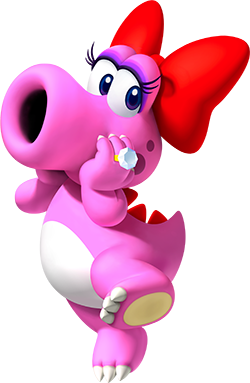
Birdo, known in Japanese as Catherine, is a character in the Mario franchise. Her first appearance was as an enemy in Yume Kōjō: Doki Doki Panic, which was localized for English-language audiences as Super Mario Bros. 2. Since then, Birdo has been a recurring character in various franchise spin-offs. Initially, she was depicted as an antagonist, but has since been depicted as an ally. Birdo has also made several cameos, particularly in the Mario Kart series and the Japan-only Wii video game Captain Rainbow.
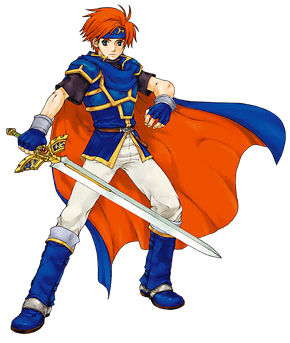
Roy is a fictional character from Nintendo's Fire Emblem video game series who, alongside Marth, first appeared in the 2001 crossover fighting game Super Smash Bros. Melee as a representative character from the Fire Emblem series. He is the lead character of Fire Emblem: The Binding Blade; within the story, he is the son of Eliwood and heir presumptive of Pherae, who eventually becomes a major military leader. The inclusion of Roy and Marth in Melee is cited as one of the reasons Nintendo started localizing the series for international distribution. Roy continues to make recurring appearances in subsequent Fire Emblem media, such as a manga series and spinoff video games.

Link is a character and the protagonist of Nintendo's video game franchise The Legend of Zelda. He was created by Japanese video game designer Shigeru Miyamoto. Link was introduced as the hero of the original The Legend of Zelda video game in 1986 and has appeared in a total of 20 entries in the series, as well as a number of spin-offs. Common elements in the series include Link travelling through Hyrule whilst exploring dungeons, battling creatures, and solving puzzles until he eventually defeats the series' primary antagonist, Ganon, and saves Princess Zelda.

Mr. Game & Watch is a 2D generic stick figure-styled silhouette character, created by Nintendo as an amalgamation of the Game & Watch handheld consoles. He was created by Gunpei Yokoi, with an intention of representing the Game & Watch collection, as the consoles had no main mascot, rather characters designed for the minigames. He debuted in Ball from Game & Watch. Mr. Game & Watch has appeared as a cameo in several other Nintendo games, such as Donkey Kong Country Returns, WarioWare: Touched!, Rhythm Heaven Fever and Super Mario Odyssey.

Ganon is a character and the primary antagonist of Nintendo's The Legend of Zelda video game series and franchise, as well as the final boss in many Zelda titles. In his humanoid Gerudo form, he is known as Ganondorf. A massive and malevolent pig creature, Ganon first appeared in the original The Legend of Zelda game in 1986, while his alter ego, Ganondorf, was introduced in Ocarina of Time. He has since appeared in the majority of the games in the series in various forms. He is the archenemy of the protagonist Link and Princess Zelda of Hyrule and originally the leader of the Gerudo, a race of humanoid desert nomads before becoming the ruler of his demon army.
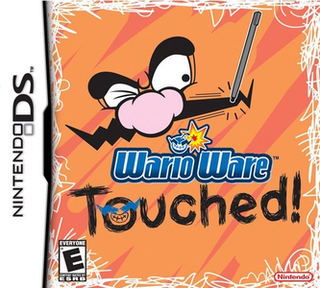
WarioWare: Touched! is a minigame compilation party video game released by Nintendo for the Nintendo DS. The fourth installment of the WarioWare series, and the first of three on the Nintendo DS, the game involves rapidly completing "microgames" — simple minigames lasting extremely short periods of time — as quickly as possible. The microgames are exclusively controlled with the Nintendo DS's touchscreen and microphone.

Masahiro Sakurai is a Japanese video game director and game designer best known as the creator of the Kirby and Super Smash Bros. series. Apart from his work on those series, he also led the design of Meteos in 2005 and directed Kid Icarus: Uprising in 2012.

Pokémon is a series of video games developed by Game Freak and published by Nintendo and The Pokémon Company under the Pokémon media franchise. It was created by Satoshi Tajiri with assistance from Ken Sugimori, the first games, Pocket Monsters Red and Green, were released in 1996 in Japan for the Game Boy, later released outside of Japan as Pokémon Red Version and Blue Version. The main series of role-playing video games (RPGs), referred as the "core series" by their developers, has continued on each generation of Nintendo's handhelds. The most recently released core series games, Pokémon Scarlet and Violet, were released on November 18, 2022, for the Nintendo Switch.
Super Smash Bros. is a crossover platform fighting game series published by Nintendo. The series was created by Masahiro Sakurai, who has directed every game in the series. The series is known for its unique gameplay objective which differs from that of traditional fighters, in that the aim is to increase damage counters and knock opponents off the stage instead of depleting life bars.

Jack Bros. is an action video game developed and published by Atlus for the Virtual Boy, released in late 1995 in Japan and North America. It is a spin-off from Atlus' video game series Megami Tensei, and was the first entry to be released outside Japan.
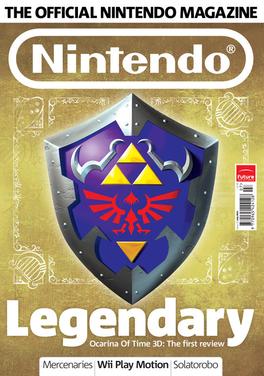
Official Nintendo Magazine, or ONM, was a British video game magazine that ran from 2006 to 2014 that covered the Nintendo DS, Nintendo 3DS, Wii, and Wii U video game consoles released by Nintendo.
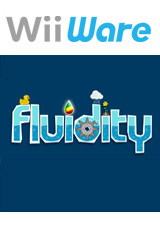
Fluidity is a physics puzzle game developed by Curve Studios and published by Nintendo for WiiWare on the Wii video game console. The game focuses on controlling a small body of water that is utilized in its different states of matter to progress through the game's levels.
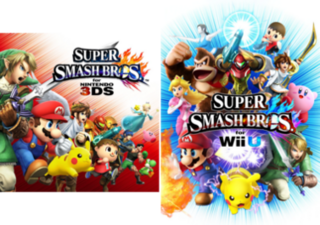
Super Smash Bros. for Nintendo 3DS and Super Smash Bros. for Wii U, both commonly referred together as Super Smash Bros. 4, are 2014 crossover platform fighter video games developed by Bandai Namco Studios and Sora Ltd. and published by Nintendo for the Nintendo 3DS and Wii U video game consoles. It is the fourth installment in the Super Smash Bros. series, succeeding Super Smash Bros. Brawl. The Nintendo 3DS version was released in Japan on September 13, 2014, and in North America, Europe, and Australia the following month. The Wii U version was released in North America, Europe, and Australia in November 2014 and in Japan the following month.

Dillon's Rolling Western, known in Japan as The Rolling Western, is a downloadable video game developed by Vanpool and published by Nintendo for the Nintendo 3DS. It is the first game in the Dillon series. Released exclusively through the system's Nintendo eShop online storefront, the game features Dillon, an anthropomorphic armadillo who must defend frontier villages from walking rock-like monsters. Dillon's Rolling Western combines elements of 3D exploration, action sequences and tower defense and was first unveiled at E3 2011 as The Rolling Western.

Pushmo, known as Pullblox in Europe and Australia and Hikuosu in Japan, is a downloadable puzzle game developed by Intelligent Systems and published by Nintendo for its Nintendo 3DS handheld system, available on the Nintendo eShop. In the game, players must shift around puzzle blocks in order to create steps and platforms, ultimately to reach children who have been trapped within the giant structures. A sequel, Crashmo, was released for the Nintendo 3DS in 2012. A third game, Pushmo World, was released for Wii U on June 19, 2014. A fourth game, Stretchmo, was released for Nintendo 3DS in May 2015.

HarmoKnight, known in Japan as Rhythm Hunter: HarmoKnight, is a rhythm platformer developed by Game Freak and published by Nintendo for the Nintendo 3DS. The game was released on the Nintendo eShop in Japan on September 5, 2012, and internationally on March 28, 2013.

Cooking Mama is a video game series and media franchise owned by Cooking Mama Limited. The series is a cookery simulation-styled minigame compilation of many video games and adventures for Nintendo gaming platforms. Generally, the gameplay revolves around performing different kitchen tasks, through the instructions of "Mama", to cook various meals. The series so far consists of five main games on Nintendo DS and Nintendo 3DS, two spin-offs on Wii, two spin offs on DS, and a spin off on 3DS. It also spins off into the Gardening Mama series. The original Cooking Mama game was also ported to iOS. A sixth main series game, Cooking Mama: Cookstar, was released for the Nintendo Switch and PlayStation 4 in 2021.


















